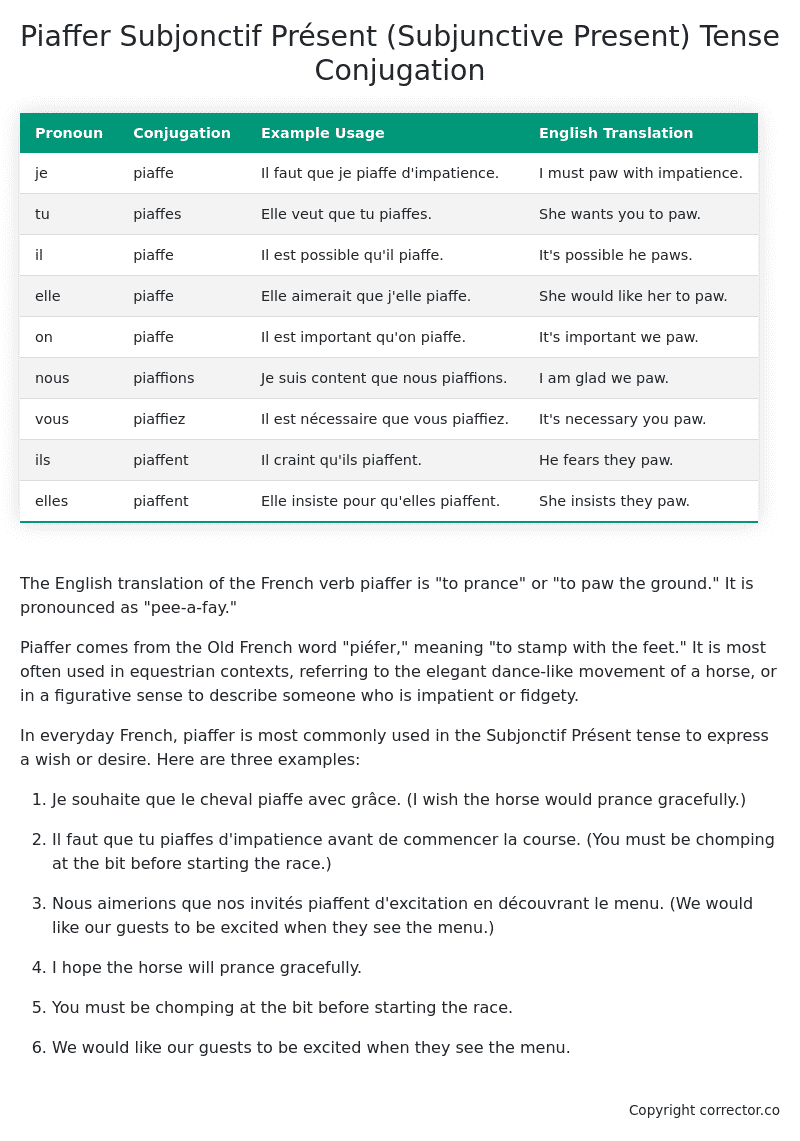Subjonctif Présent (Subjunctive Present) Tense Conjugation of the French Verb piaffer
Introduction to the verb piaffer
The English translation of the French verb piaffer is “to prance” or “to paw the ground.” It is pronounced as “pee-a-fay.”
Piaffer comes from the Old French word “piéfer,” meaning “to stamp with the feet.” It is most often used in equestrian contexts, referring to the elegant dance-like movement of a horse, or in a figurative sense to describe someone who is impatient or fidgety.
In everyday French, piaffer is most commonly used in the Subjonctif Présent tense to express a wish or desire. Here are three examples:
-
Je souhaite que le cheval piaffe avec grâce. (I wish the horse would prance gracefully.)
-
Il faut que tu piaffes d’impatience avant de commencer la course. (You must be chomping at the bit before starting the race.)
-
Nous aimerions que nos invités piaffent d’excitation en découvrant le menu. (We would like our guests to be excited when they see the menu.)
-
I hope the horse will prance gracefully.
-
You must be chomping at the bit before starting the race.
-
We would like our guests to be excited when they see the menu.
Table of the Subjonctif Présent (Subjunctive Present) Tense Conjugation of piaffer
| Pronoun | Conjugation | Example Usage | English Translation |
|---|---|---|---|
| je | piaffe | Il faut que je piaffe d’impatience. | I must paw with impatience. |
| tu | piaffes | Elle veut que tu piaffes. | She wants you to paw. |
| il | piaffe | Il est possible qu’il piaffe. | It’s possible he paws. |
| elle | piaffe | Elle aimerait que j’elle piaffe. | She would like her to paw. |
| on | piaffe | Il est important qu’on piaffe. | It’s important we paw. |
| nous | piaffions | Je suis content que nous piaffions. | I am glad we paw. |
| vous | piaffiez | Il est nécessaire que vous piaffiez. | It’s necessary you paw. |
| ils | piaffent | Il craint qu’ils piaffent. | He fears they paw. |
| elles | piaffent | Elle insiste pour qu’elles piaffent. | She insists they paw. |
Other Conjugations for Piaffer.
Le Present (Present Tense) Conjugation of the French Verb piaffer
Imparfait (Imperfect) Tense Conjugation of the French Verb piaffer
Passé Simple (Simple Past) Tense Conjugation of the French Verb piaffer
Passé Composé (Present Perfect) Tense Conjugation of the French Verb piaffer
Futur Simple (Simple Future) Tense Conjugation of the French Verb piaffer
Futur Proche (Near Future) Tense Conjugation of the French Verb piaffer
Plus-que-parfait (Pluperfect) Tense Conjugation of the French Verb piaffer
Passé Antérieur (Past Anterior) Tense Conjugation of the French Verb piaffer
Futur Antérieur (Future Anterior) Tense Conjugation of the French Verb piaffer
Subjonctif Présent (Subjunctive Present) Tense Conjugation of the French Verb piaffer (this article)
Subjonctif Passé (Subjunctive Past) Tense Conjugation of the French Verb piaffer
Subjonctif Imparfait (Subjunctive Imperfect) Tense Conjugation of the French Verb piaffer
Subjonctif Plus-que-parfait (Subjunctive Pluperfect) Tense Conjugation of the French Verb piaffer
Conditionnel Présent (Conditional Present) Tense Conjugation of the French Verb piaffer
Conditionnel Passé (Conditional Past) Tense Conjugation of the French Verb piaffer
L’impératif Présent (Imperative Present) Tense Conjugation of the French Verb piaffer
L’infinitif Présent (Infinitive Present) Tense Conjugation of the French Verb piaffer
Struggling with French verbs or the language in general? Why not use our free French Grammar Checker – no registration required!
Get a FREE Download Study Sheet of this Conjugation 🔥
Simply right click the image below, click “save image” and get your free reference for the piaffer Subjonctif Présent tense conjugation!

Piaffer – About the French Subjonctif Présent (Subjunctive Present) Tense
Formation of the Subjonctif Présent
Common Everyday Usage Patterns
Interactions with Other Tenses
Summary
I hope you enjoyed this article on the verb piaffer. Still in a learning mood? Check out another TOTALLY random French verb conjugation!


